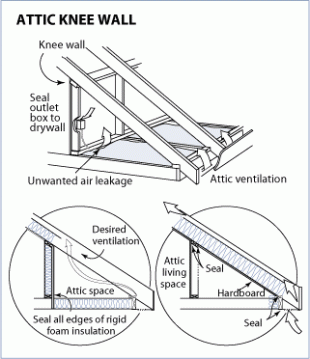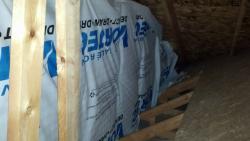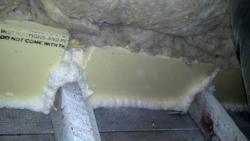- Energy Testing »
- Insulation »
- Windows
- Radon Mitigation
- Energy Solutions »
- Attic Air Sealing
- Attic Insulation
- Attic Ventilation
- Rim Joists: Insulation and Air Sealing
- Rooms above garages
- Sidewalls (Open & Closed Cavities)
- Sloped & Vaulted Ceilings
- Bathroom Exhaust Fans
- Basement Walls
- Story-and-a-half Homes: Cape Cod, Salt Box, Modified A-Frame, Bungalow
- Crawlspace Moisture Control & Insulation
- Insulation Cantilevered floors
- Ice Dams
- Rebates & Incentives »
Cape Cod, Salt Box, Modified A-Frame, Bungalow
Homes with a second “half-story” pose unique challenges for proper air sealing and insulation. Prone to ice dams and other issues, the SCES team pays story-and-a-half homes special attention. We are careful to maintain adequate air sealing, insulation, and ventilation at every step.
Anatomy of a Story-and-a-Half Home
All story and a half homes have some variation of the following components:
Flat or “Collar” Attic
In this type of attic, the flat ceiling of the second story forms the floor of a small attic space near the peak of the home. Some homes have a cathedral or vaulted ceiling in lieu of a collar attic.
Knee Walls
Knee walls are the short, “knee height” walls along the perimeter of the room. They separate the finished space from the often unfinished side attics.
Slant Walls
These are the slanted wall portion of the room. These walls follow the underside of the roof rafters from the top of the knee wall to the bottom of the collar attic.
Side Attics
Side attics form the ceiling of the story below, and offer great storage spaces for seasonal items.
Your planned use of the space determines how best to insulate and air seal your home. There are two basic arrangements of the story-and-a-half home:
Arrangement One: Fully Conditioned Roofline (Conditioned Side Attics)

Insulating between the rafters of a story-and-a-half home, from the eave to the peak, brings the entire upper floor into the “conditioned space” of the home. That means that the side attics are kept at or near the temperature of the rest of the home. The challenge with this arrangement is ensuring adequate insulation and ventilation are provided in a very small space in the rafters (often as little as 3½ or 5½ inches of space).
The SCES team has a few suggested treatments to overcome this
challenge:
Dense Pack the Slants
Insulation can often be added to the slant walls by densely packing in a loose fill insulation material.
Ventilate the Roof Deck
Ventilation can often be improved by installing or propping open ventilation chutes. Proper “high side” ventilation should also be present near the peak, which requires that roof vents (or a continuous ridge vent) be cut into the roof above the collar attic.
Add Foam Board Insulation to Side Attic Ceilings
Insulation can be added in the side attic areas by attaching rigid foam board insulation to the underside of the rafters.
Air Seal the Exterior Wall Top Plates with 2-Part Foam
The connection between the rafters and the exterior walls of the floor below should be foam sealed to reduce air infiltration.
Arrangement Two: Unconditioned Side Attics
In this arrangement, side attics are “unconditioned,” meaning the air in them is often vented to the outdoor air. The extreme temperatures swings in the side attics from season to season lead to temperature swings in the upper floor rooms as well. These rooms are freezing cold in winter and stiflingly hot in summer. Homeowners with unconditioned side attics often convert this space to a fully conditioned roofline (like in the first arrangement).
SCES has a few additional suggestions for improvements, including:
Add Ventilation to Side Attics
Adding ventilation chutes in each rafter bay allows cool air to enter the side attic. Similarly, inserting vent chutes into the slant walls allows air to flow properly (up from the eaves, through the side attic, up the slants, and out through a ventilated collar attic). The roof must have proper “high side” ventilation near the peak, which often requires cutting roof vents (or a continuous ridge vent) into the roof above the collar attic.
Fully Insulate Knee Walls

Basic, unfaced fiberglass batts installed in the knee wall do not sufficiently isolate the side attic from the conditioned interior space. The backside of the knee walls should be covered with rigid foam board insulation or with a vapor-permeable building paper (like Tyvek® or Weathermate®). Using building paper and foam board prevents the unconditioned air, whether it’s cold winter air or hot summer air, from permeating the bare fiberglass batts.
Install Blocking Below the Knee Wall

The floor joists below knee walls are an often overlooked component of your home’s thermal envelope. Our team installs sealed blocking between each joist bay to prevent conditioned air from escaping.
Fully Insulate Side Attic Floors
If they are not being used for storage, side attic floors can be piled high with loose-fill insulation. Thermal resistance of R-60 is recommended for the Wisconsin/Twin Cities Metro Area climate zone. If the side attic has a floor and will be used for storage, the joist bays can be densely packed with insulation. Once dense-packed, foam board insulation can be laid on top of floor decking to increase the R-Value of the storage floor.
Air Seal the Exterior Wall Top Plates with 2-Part Foam
The connection between the rafters and the exterior walls of the floor below should be foam sealed to reduce air infiltration.
No matter the arrangement of your one-and-a-half story home, the SCES team is ready to work to make sure your home is working as efficiently and cost-effectively as possible. If you’re ready for lower energy bills and improved home comfort, get in touch with us to set up an evaluation.
Contact UsEnergy Assessments for $450 or less
Schedule your FREE Home Estimate
Testimonials
John Williams, Hudson, WI
They came out and used spray foam insulation along our entire rim joists. They also foamed the holes in the attic where air is escaping, covered recessed lights with boxes and then blew in additional cellulose insulation to reach a final value of R60.
They were very professional. They came in at the time they said they were coming. They went right to work. The work went smoothly and ended before their estimated ending time. They even came back out a couple of times to help touch up some areas and help with a particular problem area that air was leaking through. We finally stopped the draft and we are very satisfied with the work that was done. Our house feels much mo... (read more)
